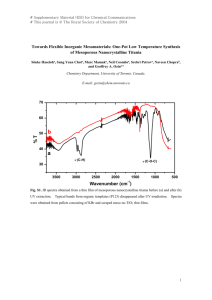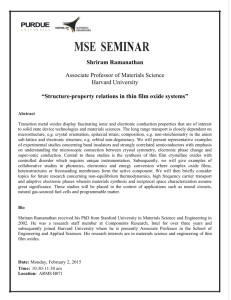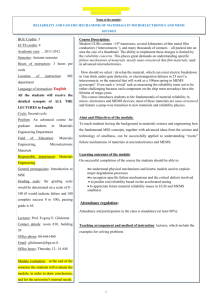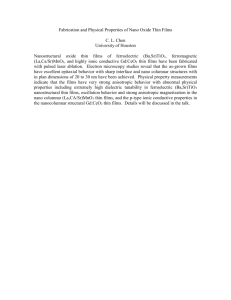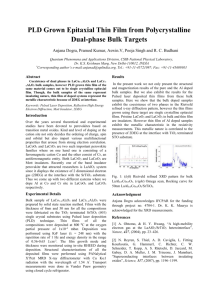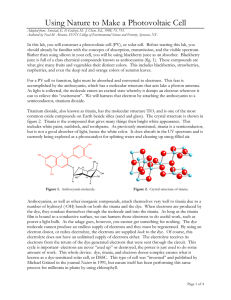Nano engineered titania thin films for advanced materials
advertisement
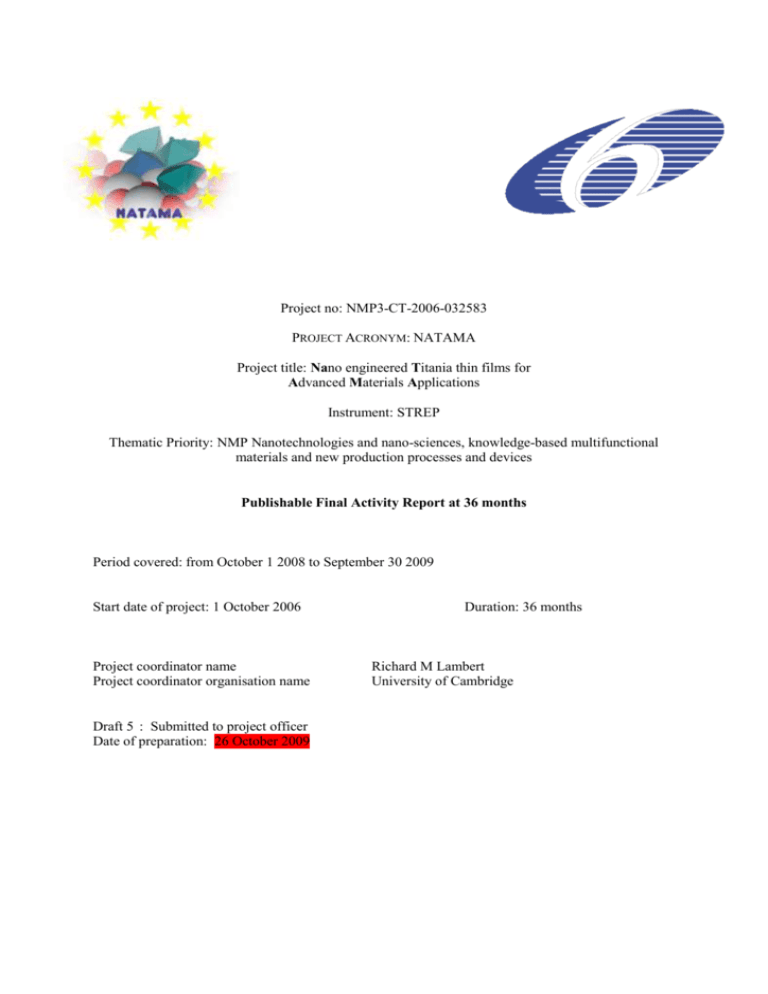
Project no: NMP3-CT-2006-032583 PROJECT ACRONYM: NATAMA Project title: Nano engineered Titania thin films for Advanced Materials Applications Instrument: STREP Thematic Priority: NMP Nanotechnologies and nano-sciences, knowledge-based multifunctional materials and new production processes and devices Publishable Final Activity Report at 36 months Period covered: from October 1 2008 to September 30 2009 Start date of project: 1 October 2006 Project coordinator name Project coordinator organisation name Draft 5 : Submitted to project officer Date of preparation: 26 October 2009 Duration: 36 months Richard M Lambert University of Cambridge Titanium dioxide, hereafter referred to as titania, undergoes activation by ultra violet radiation which can induce a variety of interesting and potentially useful chemical and physical phenomena in the material. However, ultra violet radiation constitutes only about 5% of the sunlight arriving at the earth’s surface. Accordingly, the overall aim of the NATAMA project was to produce titania-based thin film materials that can be activated by visible light, thus greatly enhancing the efficiency of the various possible photo-activated processes and opening the door to practical implementation of a range of applications that could then be powered by sunlight or by ambient light within buildings. Effective activation of titania films by visible light would constitute a major advance, hugely increasing their potential for practical use in a variety areas including photocatalysts for environmental and health protection, energy production via water splitting, and the synthesis of chemicals. Strategies for inducing visible light activation of titania include the exploitation novel nanoarchitectures, creation of nano-composite systems, and the doping such materials with small amounts of foreign atoms such as boron, carbon or nitrogen. A major obstacle to progress has been the lack of understanding of the relationship between synthetic method, nano-architecture, the structure of these substances at the atomic level and the desired physico-chemical properties. Achieving this understanding was one of our main goals. Moreover, for practical applications to be realized, it is important that synthetic methods be developed that are reproducible, low-cost and capable of being scaled up: this was the second major aim of the NATAMA project. We pursued these objectives by developing a variety of new thin film fabrication methods and analyzing in detail the physical and chemical properties of the resulting materials using a range of state of the art experimental techniques. The work was carried out by a consortium comprised of four academic and two industrial partners with well-matched and complementary skills and experience, drawn from three countries and including two end-users who between them cover the main areas envisaged for exploitation of the results. The participating bodies were: University of Cambridge, Department of Chemistry, University of Messina, Department of Industrial Chemistry and Engineering of Materials, University of Oxford, Department of Chemistry, Instituto de Ciencia de Materiales de Sevilla (CSIC), Mantis Deposition Ltd (UK), Abengoa Solar S.A. (Spain). The work was carried out by means of interdependent workpackages, each with its own leader, and designed to exploit the complementary strengths of the partners. New nanostructured materials incorporating precisely engineered architectures were created, produced as thin films, and optimized with respect to the intended application, the most important of which is the use of sunlight to generate hydrogen from water. Figures 1-3 illustrate some of the chemically-modified titania thin film nanostructures that were created and evaluated for their performance as visible light-activated materials. Figure 1. (a) scanning electron microscopy image of a thin film consisting of titania nanorods created by a plasma technique (b) nitrogen-doped titania thin films, top and side views. 2 0.01 m m 0.0001 mm 0.001 m m 0.00004 mm Figure 2. Image of a titania thin film prepared by electrochemical method and exhibiting a nano-coil architecture. Figure 3. Atomic force microscopy image of a nitrogen-doped titania thin film prepared by post annealing a PVD film in ammonia. As noted above, an important aspect of the project was the development of methods for coating large areas with these multi-functional solar-activated materials, ultimately to enable practical applications. A very promising method for depositing chemically modified titania thin films over large areas was developed by one of the industrial partners. The principle is illustrated in Figure 4a and an example of a boron-doped titania thin film made in this way is shown in Figure 4b. Figure 4. (a) Showing production of a beam of boron-doped TiO2 nanoparticles which were then deposited to form a film on a silicon surface. (b) image of the resulting boron-doped TiO2 thin film prepared by particle condensation. Figure 5 illustrates how incorporation of trace amounts of foreign atoms by the above method into the titania thin film leads to the absorption of visible light: films M1 and M2 contained no carbon and showed no catalytic activity when irradiated with visible light. In marked contrast, sample M3, which contained a small amount of carbon, was a good visible light-activated photocatalyst. 3 Figure 5. Absorption spectra of three thin films produced by the method shown in Figure 2. M3 is carbon-doped and exhibits visible light-induced catalytic activity; M1, M2 are un-doped and inactive. All the methods used for synthesizing the photo-functional titania thin films were new and have never previously been described. The culmination of these activities was reached during the final stages of the project with the production scaled-up samples of the most promising thin film materials. These were then tested using sunlight at the Abengoa Solar facility located near Seville, as shown in Figure 6. Figure 6. Installation of the photocatalytic experiment on the solar tracker at the Abengoa site. Additionally, a very successful ancillary project was executed which involved the application of a new method for applying a protective coating to the optical lenses used for concentrating sunlight for use in high intensity photovoltaic technology. The coating produced three beneficial effects (i) it protects the lenses against damage by ultraviolet light radiation (ii) it creates a so-called hydrophilic (water-attracting) surface that enables self-cleaning of the lenses by rainwater (iii) it provides antireflective properties that improve light transmission through the lens. These lenses have performed well in field trials. In summary, the NATAMA project has met all its stated objectives. Nanostructured thin film materials chemically modified so as to produce desirable physico-chemical photo-responses under the influence of visible light were successfully produced. These best of these materials were at least as effective or better than those already available under current state of the art. Moreover, we invented “wet” and “dry” methods for coating such visible light-activated thin films on much larger surface areas than previously achieved, opening the door to practical implementation. Medium to long term benefits for European competitiveness (especially for SMEs) are expected in regard to the development of coating equipment and technology, solar technology, anti-microbial coatings for medical equipment and purification of water and ambient air. 4
